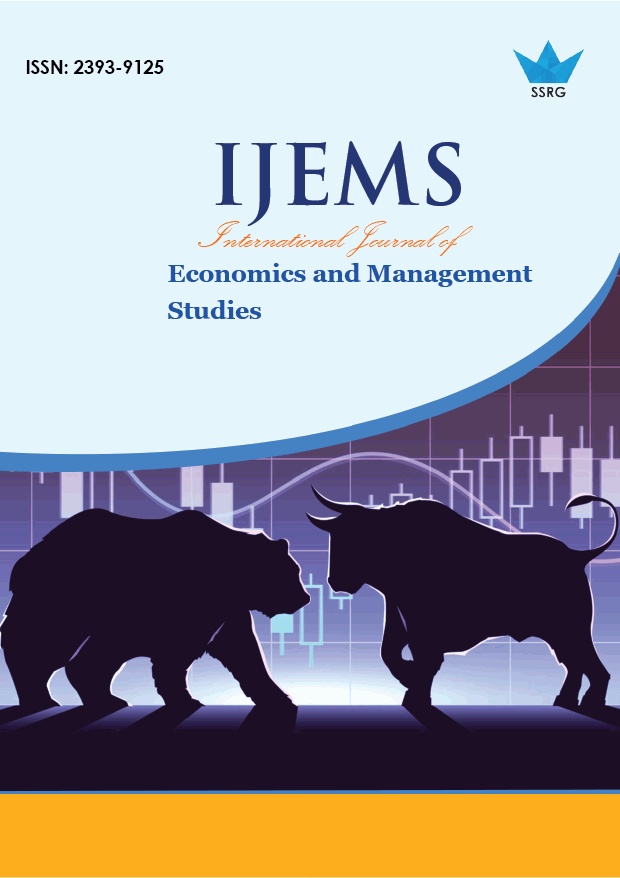The Relationship between Capital Structure and Profitability in Commercial Banks: Evidence from Iran

| International Journal of Economics and Management Studies |
| © 2015 by SSRG - IJEMS Journal |
| Volume 2 Issue 11 |
| Year of Publication : 2015 |
| Authors : MohammadReza Asgari, Sareh Pahlavan, Mostafa Pahlavan |
How to Cite?
MohammadReza Asgari, Sareh Pahlavan, Mostafa Pahlavan, "The Relationship between Capital Structure and Profitability in Commercial Banks: Evidence from Iran," SSRG International Journal of Economics and Management Studies, vol. 2, no. 11, pp. 7-15, 2015. Crossref, https://doi.org/10.14445/23939125/IJEMS-V2I5P106
Abstract:
This study aims to investigate the relationship between the profitability and the capital structure of banks. The statistical population of this research consists of all public and private banks for a decade from 2003 to 2012. Using the screening method, the sample is comprised of 18 public and private banks. In this study, return on assets, return on equity, and committed net interest margin are selected as dependent variables and debt-to-equity ratio and debt-to-assets ratio are considered as independent variables. This research exploits compilation and panel (board) data with random and fixed effects and data analysis results at the 95% confidence level shows that Debt-to-equity and debt-to-assets have a direct and significant relationship (p<0.05) with return on equity and return on assets. Moreover, results indicate that there is no significant relationship between debt-to-equity and debt-to-assets ratios and the committed net interest margin of the banks.
Keywords:
return on equity, return on assets, committed net interest margin, Debt-to-equity, debt-to-assets.
References:
1. Abor J. (2005). The effect of capital structure on profitability: an empirical analysis of listed firms in Ghana. Journal of Risk Finance, 6, 438-47.
2. Aggarwal R., Kyaw N .(2010). Capital structure, dividend policy, and multinationality: Theory versus empirical evidence. International Review of Financial Analysis, Elsevier, vol. 19(2), 140-150.
3. Antoniou AC, Pharoah PD, McMullan G, Day NE, Stratton MR, Peto J, Ponder BJ, Easton DF (2002). A comprehensive model for familial breast cancer incorporating BRCA1, BRCA2 and other genes. Br J Cancer 86,76-83
4. Barker G.(1995). Situational Analysis of Drug Abuse among Youth at-Risk in the Caribbean: A Needs Assessment of Out-of-School Youth in St. Vincent and the Grenadines, Trinidad and Tobago, St. Maarten and Jamaica. Mimeo. UNDCP.
5. Bose R. (2002). Customer relationship management: key components for IT success. Industrial Management & Data Systems, 102(2), 89-97. http://dx.doi.org/10.1108/02635570210419636.
6. Chen S.(2011). Capital ratios and the cross-section of bank stock returns: Evidence from Japan. Journal of Asian Economics, Elsevier, vol. 22(2), 99-114.
7. Collins D., Maydew W. (1997).Changes in the value-relevance of earnings and book values over the past forty years,Journal of Accounting and Economics, 24, 39- 67.
8. Cornett M.M.; J.J. McNutt; and H. Tehranian. (2009). Corporate Governance and Earnings Management at Large U.S. Bank Holding Companies. Journal of Corporate Finance, 15, 412-430.
9. Dimitris M., Psillaki M. (2010). Capital structure, equity ownership and firm performance. Journal of Banking & Finance, Elsevier, vol. 34(3), 621-632.
10. Drobetz A., Baker M., Wurgler J.(2007). How Persistent is the Impact of Market Timing on Capital Structures?. Review of Financial Studies, No. 1, 1- 33.
11. Fakhari, Hossein. Taghavi, roohollah. (1388). Accruals quality and balance of cash flows. The Iranian Accounting and Auditing Review. 16(58). 69-84.
12. Haghighat, Hamid. Bashiri, Vahab.(1391). Examining relationship between financial flexibility and capital structure. Accounting Knowledge. 3(8). 49-71.
13. Niresh J A .(2012). Capital Structure & Profitability in Srilankan Banks. Global Journal of Management & Business Research, Vol. 12, 83-90
14. Pahlavan, S., Talebnia, Gh. (2014). Analysing the Relationship between Earnings Transparency and Excess Return of the Companies in Tehran Stock Exchange. SSRG International Journal of Economics and Management Studies, 2(5): 1-10.
15. Pandey I M. (2009). Financial Management: Capital Structure Planning and Policy, 332- 333.
16. Saghafi, Ali. Aghaei, Mohammadali.(1373). Behavior of accounting income. The Iranian Accounting and Auditing Review, 21(5).
17. Setayesh, MohammadHossein. Monfared, Mohammad. Ebrahimi, Fahimeh. (1390). Examining effective factors on capital structure based on agency theory. Human science journal. 3(1). 55-89.
18. Sinaei, Hasanali. Solgi, mohammad. Mohammadi, Kamran. (1390). Examining effect of growth opportunities on the relationship between capital structure, dividend, ownres structure and firm value. Journal of Financial Accounting Research. 4(3). 87-102.
19. Song Shin H., Adrian T.(2009). Federal Reserve Bank of New York Staff Reports. Working Paper, http://papers.ssrn.com/.
20. Taub A J.(1975). Determinants of the firm’s capital structure. The Review of Economics and Statistics 57, 410-416.
21. Titman S. (1984). The Determinants of Capital Structure Choice. Journal of Finance Vol. 43 -19.
22. Vives X. (2006). Banking and Regulation in Emerging Markets: The Role of External Discipline. World Bank Research Observer, Vol.21,Iss.2,176-206.

 10.14445/23939125/IJEMS-V2I5P106
10.14445/23939125/IJEMS-V2I5P106